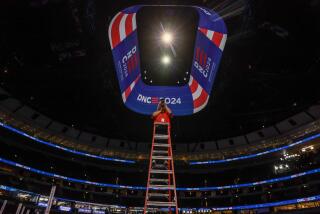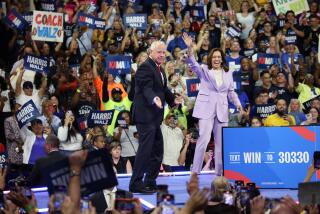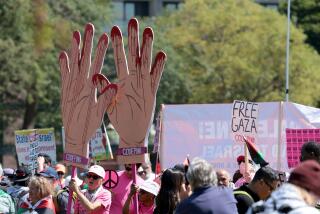Unions Hope to Demonstrate Solidarity
Hundreds of thousands of demonstrators are expected to flood into Washington on Aug. 31 in what promises to be one of the largest political demonstrations in U.S. history. Its organizers hope that it will be evidence of a revival of the once-powerful liberal-labor-minorities coalition.
Joining union members from across the nation in the AFL-CIO-sponsored Solidarity Day II will be members of about 150 organizations of environmentalists, civil rights advocates, senior citizens, churches and women.
Solidarity Day I in 1981 drew crowds estimated between 200,000 and 300,000, but that coalition effort did little to slow the political march to the right led by then-President Ronald Reagan, who set the anti-labor tone of the Reagan and Bush administrations that year by permanently firing 11,000 illegally striking air traffic controllers.
This yearâs political demonstration should be far larger, and therefore possibly more effective. Some organizers say privately that it might draw more people than any previous public show of political strength, which would mean a crowd of more than 750,000.
Thousands of buses and several Amtrak trains have already been chartered, special discount plane fares arranged, and caravans of cars and vans lined up to transport participants from every state.
None of the organizers will predict the turnout; if the number is less than a record, or near one, they fear an overestimate will emphasize the obvious decline in the strength of organized labor and its allies.
But the reverse is true too. If it does draw as many people as the optimists whisper, it could signal a possible change in the fortunes of labor and its allies.
Self-evident is the need to revitalize and reunite the weakened coalition of liberals, unions and minorities that once provided the Democrats with their basic strength.
They have failed to win most of their objectives, which range from universal health care and anti-poverty programs to civil rights and abortion rights, from labor law reform to parental leave. The coalitionâs goals also include a fair, less regressive tax system than our current one, which favors those in high income brackets.
Often they have failed to get their proposals through Congress, even though it is controlled by their presumed allies, the Democrats; they are still struggling for power against the more conservative wing of the Democratic Party.
The coalition is united primarily on domestic issues, but President Bushâs popularity rests on international questions. As one observer put it, Bush has become a âdiplomaniac,â concentrating far more on international than domestic matters. And that could lead to defeat in his reelection bid, if the march helps focus the electorate on Bushâs failures on the domestic front.
But a one-day demonstration, no matter how massive, isnât suddenly going to change the basically conservative political environment.
It could surely help, however, and encourage the Democrats to nominate a populist progressive like Sen. Tom Harkin (D-Iowa) or the more moderate progressive, New Yorkâs Gov. Mario Cuomo.
First, though, the Aug. 31 march can demonstrate to wishy-washy Democrats that there really is a vocal constituency out there ready to work for the causes they support.
âThe march is part of the fight to give the Democratic Party its proper bearings,â says Howard Samuel, head of the AFL-CIO Industrial Union Department, who justifiably argues that âour coalition is the real base for a party that can win.â
One of the issues to be stressed by demonstration speakers is health care, an increasingly serious problem for everyone and a politically potent one.
Another priority issue dealing just with labor is a measure to restore sense to federal law, which gives workers the right to strike without fear of being fired but which was rendered meaningless when employers began seizing on an old Supreme Court ruling.
The court decided in 1938 that workers cannot be fired for striking, but they can be permanently replaced--as though one way of breaking a strike was better than the other.
It was rare for employers to permanently replace strikers until Reagan popularized the idea by firing the air traffic controllers. The House recently passed a bill correcting the illogical court ruling, and the Senate is expected to pass it also.
Predictably, Bush has said he will veto the measure. But the simple argument in its favor--that workers have a constitutional right to strike--is so persuasive that it seems to have rallied almost unanimous support among union members and laborâs allies in the coalition.
Coalition leaders hope such support on this and other issues will be dramatized by the marchers, helping to push Congress not only to override a Bush veto of this bill, but to slow if not reverse the general trend toward the political right.
After Solidarity Day, the next opportunity for labor alone to increase its political role will come after the AFL-CIO national convention in Detroit in mid-November. Any announced candidates for the Democratic presidential nomination will be invited to attend the convention and debate the liberal-labor-minorities agenda.
If a consensus can be reached on a candidate, there will be a labor endorsement before the Iowa caucuses begin Feb. 17. It would be only the second time that labor has made a pre-primary presidential endorsement, and in a close race for the nomination, it could be decisive.
Laborâs detractors say a labor endorsement might well help Harkin, Cuomo or some other liberal win the nomination, but would hurt the candidate in the general election by tagging him as laborâs âcaptive.â
Despite that unproven argument, labor and its allies are the Democratsâ best hope for ending the ultra-conservative era of Reagan and Bush. Trying to mimic the Republicans, as some Democratic Party leaders seem to prefer, wonât do much for the Democrats and would offer nothing--not even a choice--for the nation.
More to Read
Sign up for Essential California
The most important California stories and recommendations in your inbox every morning.
You may occasionally receive promotional content from the Los Angeles Times.










